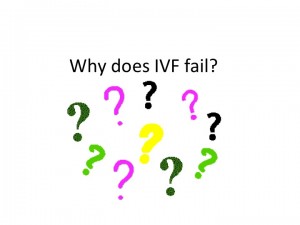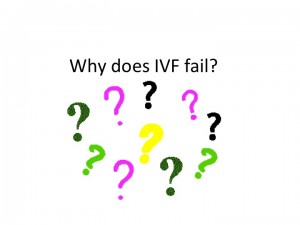We are experiencing a very high volume of calls and messages and ask for your patience. We will answer your portal messages within 48 hours.
We are experiencing a very high volume of calls and messages and ask for your patience. We will answer your portal messages within 48 hours.

 According to the latest statistics from the Society for Assisted Reproductive Technologies (www.sart.org) in the year 2011, there were a total of 154,412 cycles performed in the US. The pregnancy rates have increased compared to a few years ago, but even in young patients (< 35 y), the live birth rate remains less than 50% (46.3% per transfer). In older patients, the pregnancy rates are lower (38.4% in ages 35 – 37 y, 27.5% in ages 38 – 40 y, 16.6% in ages 41 – 42y and 6.5% in ages > 42 y). Even with egg donors, the live birth rate in 2011 was 54.9%. A relevant question would be to ask, “Why does IVF fail?” Why don’t we have a 100% pregnancy rate? Why do pregnancy rates drop in older patients? This blog will briefly try and answer these very important questions. These are also some of the issues that are part of the discussion when I meet with patients after an unsuccessful IVF cycle. Read on.
According to the latest statistics from the Society for Assisted Reproductive Technologies (www.sart.org) in the year 2011, there were a total of 154,412 cycles performed in the US. The pregnancy rates have increased compared to a few years ago, but even in young patients (< 35 y), the live birth rate remains less than 50% (46.3% per transfer). In older patients, the pregnancy rates are lower (38.4% in ages 35 – 37 y, 27.5% in ages 38 – 40 y, 16.6% in ages 41 – 42y and 6.5% in ages > 42 y). Even with egg donors, the live birth rate in 2011 was 54.9%. A relevant question would be to ask, “Why does IVF fail?” Why don’t we have a 100% pregnancy rate? Why do pregnancy rates drop in older patients? This blog will briefly try and answer these very important questions. These are also some of the issues that are part of the discussion when I meet with patients after an unsuccessful IVF cycle. Read on.
For IVF to work we need “good” egg and sperm to make “normal” embryos that will result in a pregnancy when “properly” placed in a “receptive” uterus. Let us now discuss each of these issues in detail.
This is probably the most difficult issue we face in reproductive medicine. A woman is born with all the eggs she will have and with age the egg quality diminishes with an increase in chromosomal abnormalities (aneuploidy). Also, women do have a “biological clock” and in some women the egg quality will decrease prematurely (diminished ovarian reserve, DOR). We have tests to diagnose DOR and suggestions to optimize fertility. However, currently there is no treatment for “bad” eggs. This is one of the most common reasons for IVF failure. The live birth rate for women < 35 y with a diagnosis of DOR was 36.5% in 2011 despite a high cycle cancellation rate (16.1%)! The pregnancy rate will of course be MUCH lower with severe egg factor.
Not much of a problem in most cases. With the advent of intracytoplasmic sperm injection (ICSI) we are able to overcome most cases of male factor infertility. We are currently routinely able to help couples where the wife makes more eggs than the husband sperm! Even in men with no sperm in the ejaculate, we are able to retrieve sperm from the testes (testicular sperm aspiration, TESA) and achieve pregnancy. According to SART, in 2011 the live birth rate for patients with a diagnosis of male factor was 48.3% in women < age 35 y. However, the pregnancy rate will be much lower when there are chromosomal abnormalities in the male (e.g. balanced translocation). A man makes new sperm every 72 days or so. This is the reason why older men are able to father children (e.g. Charlie Chaplin, Anthony Quinn, Rod Stewart).
During IVF we generally stimulate patients with fertility drugs (gonadotropins, FSH, hMG) to produce multiple eggs. If the stimulation is sub-optimal, then it will result in poor quality eggs being retrieved. Critical aspects of stimulation include choice of medications, dose and duration. If the hCG trigger shot is given too early or too late, the egg quality will once again be compromised (immature or post mature eggs). A good quality stimulation can make a huge difference in the outcomes.
Embryology laboratory
Laboratory culture conditions need to be optimal for IVF to work. The details of what happens in the embryology lab have been outlined in a previous blog. Textbooks have been written on quality control in an embryology lab. The details are beyond the scope of this blog.
During IVF, approximately 50% of human embryos are chromosomally abnormal (aneuploid). This is so even when an egg donor is used. In older patients, 70 – 100% of embryos will be aneuploid. The good news is that most of these abnormal embryos will not implant. We try to overcome this issue by transferring more than one embryo. The hope is that of the two (or more) embryos, one will implant. But sometimes both will implant resulting in twins and rarely triplets (if in addition an embryo splits into two).
For the past few years, it has been possible to screen embryos for aneuploidy prior to embryo transfer. This technique is call pre-implantation genetic diagnosis (PGD) or pre-implantation genetic screening (PGS). Till recently, PGD was done only in select cases and only a limited number of chromosomes could be evaluated. With the advent of 23-chromosome screening and rapid turnover time in getting test results, it is now possible to do a fresh transfer of screened embryos. Most patients will be better off with freezing the biopsied embryos and transferring them in a subsequent cycle. It is now possible to get excellent pregnancy rates even with elective single embryo transfer. Liza Meyer will present this exciting new technology in a follow up blog.
Embryo transfer (ET) is a critical step for an IVF cycle to succeed. For implantation to occur, the embryo(s) must be transferred without damage (atraumatically) into the uterine cavity. Several improvements have occurred over the past decade, that have resulted in optimizing ET technique. This includes the use of soft catheters, ultrasound-guidance, removing the cervical mucus, avoiding instruments to grasp the cervix (tenaculum), avoiding touching the uterine fundus with the catheter tip, transferring the embryo (s) in the middle or lower third of the cavity etc. Most good clinics will monitor individual physician ET pregnancy rates as part of an ongoing quality control routine.
Most IVF cycles will fail after ET. A relevant question one can ask is, “Is the body rejecting the embryos?” This used to be a hotly debated issue 15 – 20 years ago when IVF pregnancy rates were much lower. A hypothesis suggested by a small group of investigators was that implantation failure was due to the immune system rejecting the embryos. Of interest is the fact that almost 40% of infertile patients will have at least one abnormality when these immune panels were done. This resulted in a large number of patients being treated with blood thinners (Heparin, Lovenox, baby aspirin) and even expensive therapies such as intravenous gamma-globulin (IVIG).
There was a paper from a group of investigators (Denis et al.) that published a paper in the late nineties that seriously questioned the validity of these tests. They ran these immune panels on approximately 700 consecutive IVF patients. The results were very interesting. There was NO correlation between the immune test results and who got pregnant, who did not get pregnant, who miscarried and who had a baby!
The current thinking is that it is possible that the immune system has a role in implantation failure. There, however, isn’t a single test that can reliably detect these patients. At InVia, we have not recommended these tests for many years now.
To summarize, egg and embryo quality are the major reasons why IVF fails. With current technology, it is now possible to screen embryos for aneuploidy. However, there are more than 20,000 genes and currently it is not possible to screen embryos for every genetic disease known to man. Also important are good stimulation protocols, quality control in the embryology lab and ET technique.
IVF InVia Fertility Specialists Diminished ovarian reserve Embryology

Entire Website © 2003 - 2020
Karande and Associates d/b/a InVia
Fertility Specialists
